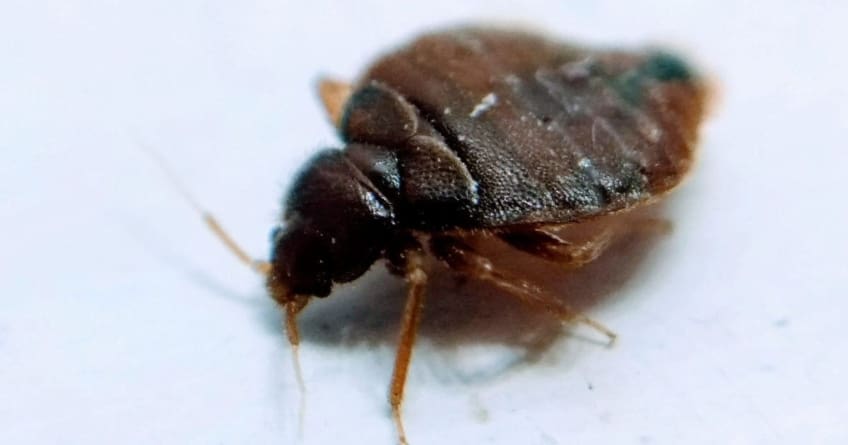
What are bedbugs?
Bedbugs are oval-shaped, wingless parasites. They have 6 legs and are about 1/5 of an inch long. They range in color from white to brown, and look dark red after feeding. Bedbugs feed on blood during the night and hide during the day. They prefer human blood, but also will feed on other mammals, such as dogs or cats.
Bedbugs live in dry, dark openings, such as mattress seams. Mattresses are ideal because bedbugs feed at night. However, they live in more places than just mattresses. They can live in gaps in your furniture, walls, or floors, then crawl into your bed at night. Places such as hotels, apartments, dorms, and shelters are more likely to be infested with bedbugs. This is because more people come and go in these places. Bedbugs can travel from place to place on clothing, luggage, furniture, and used bedding.
Symptoms of bedbugs
Bedbug bites show up as small, swollen, red bumps. They may or may not have a bite mark in the center. The bites are very itchy. It is common to have several bites at a time, often in a straight row on your skin.
Other signs that you have bedbugs are:
- Small bloodstains on your sheets
- Dark flecks of bedbug feces in places where bedbugs might live
- A sweet odor that indicates the presence of a large number of bedbugs
The best time to search for live bedbugs is in the middle of the night when they come out to feed.
What causes bedbugs?
Bedbugs are a growing problem in the United States. One cause could be an increase in international travel. This leads to people bringing bedbugs back in their luggage or on their clothes. The change in pesticides is another possible cause. Chemicals that used to get rid of bedbugs in the past have been replaced with milder chemicals that do not harm bedbugs. This has allowed the bedbug population in the United States to grow.
How are bedbugs diagnosed?
A doctor can usually diagnose bedbug bites. You should call your doctor right away if:
- Your bites become red and swollen
- Your bites form blisters or sores
- You have a fever
You may have an infection or a severe allergic reaction.
Can bedbugs be prevented or avoided?
Insect repellent does not keep bedbugs away. The best way to prevent them is to avoid bringing them into your home. When you travel, be sure to inspect your bed for signs of bedbugs before you sleep in it. Check your luggage for bed bugs before and after you travel. Inspect all used furniture before you bring it home. If you buy used clothes, bring them home in plastic bags and wash them right away in hot water. Try to keep bedrooms clean and picked up. Dirt and clutter give bedbugs more places to hide.
Bedbugs treatment
Bedbug bites should go away within 2 weeks. You can apply an over-the-counter (OTC) hydrocortisone cream or lotion on the bites to relieve the itchiness and swelling. An OTC antihistamine pill or cream called diphenhydramine (brand name: Benadryl) can relieve itchiness as well. It’s important to avoid scratching your bites as much as possible. Scratching can damage your skin, which can cause an infection.
If an OTC treatment doesn’t help, you may need to call your doctor. They can order a prescription-strength medicine to treat your symptoms. They also will prescribe an antibiotic if you have an infection.
Living with bedbugs
Bedbugs can be a terrible nuisance, but they have not been shown to spread disease.
If you have bedbugs in your home, wash all of your clothes and bedding in hot water. The water temperature must be at least 120°F to kill the bedbugs. Then, dry them in a hot dryer. If possible, avoid taking your laundry to a public laundromat or dry cleaner. This can lead to a bedbug outbreak.
Vacuum all of your luggage and furniture, including your mattress and box springs. If anything is infested, either replace it or cover it with plastic. Dark plastic works better. Then, place it in a dry spot with direct sunlight. The hotter it is the more bedbugs will die from the heat. Keep the item in sunlight for at least 24 hours. Afterward, fix any cracks in your furniture. Fill and seal any cracks or holes in the walls or floors.
If it is cold outside, you can freeze the infested items instead. Place them in a dry, shaded spot outside. Freezing will take 2 to 4 days at 0°F and about 7 days at 20°F.
If your infestation is severe, you may need to contact a pest control professional. Ask questions about what chemicals they use. Be sure to keep children and pets away during the treatment.
Questions to ask your doctor
- How can I be sure I have bedbugs?
- How do I get rid of bedbugs to make sure they don’t come back?
- Can I transmit bedbugs to and from other places on my body or clothing?
![]()
Copyright © American Academy of Family Physicians
This information provides a general overview and may not apply to everyone. Talk to your family doctor to find out if this information applies to you and to get more information on this subject.









